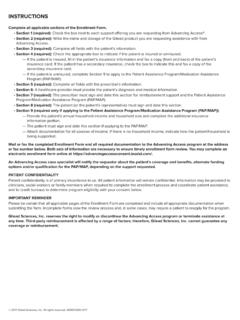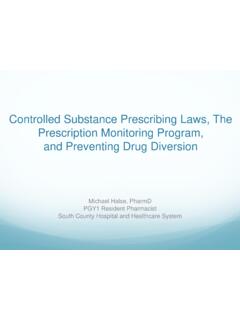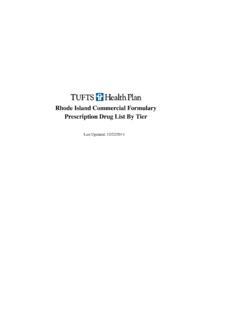Transcription of Prescription Drug Benefit Manual - CMS
1 Prescription drug Benefit Manual Chapter 9 -Compliance Program Guidelines and Medicare Managed Care Manual Chapter 21 Compliance Program Guidelines Table of Contents (Chapter 9 -Rev. 16, 01-11-13) (Chapter 21 -Rev. 110, 01-11-13) Transmittals for Chapter 9 10 Introduction 20 Definitions 30 Overview of Mandatory Compliance Program 40 Sponsor Accountability for and Oversight of FDRs 50 Elements of an Effective Compliance Program Element I: Written Policies, Procedures and Standards of Conduct Standards of Conduct Policies and Procedures Distribution of Compliance Policies and Procedures and Standards of Conduct Element II: Compliance Officer, Compliance Committee and High Level Oversight Compliance Officer Compliance Committee Governing Body Senior Management Involvement in Compliance Program Element III.
2 Effective Training and Education General Compliance Training Fraud, Waste, and Abuse Training Element IV: Effective Lines of Communication Effective Lines of Communication Among the Compliance Officer, Compliance Committee, Employees, Governing Body, and FDRs Communication and Reporting Mechanisms Enrollee Communications and Education Element V: Well-Publicized Disciplinary Standards Disciplinary Standards Methods to Publicize Disciplinary Standards Enforcing Disciplinary Standards Element VI: Effective System for Routine Monitoring, Auditing and Identification of Compliance Risks Routine Monitoring and Auditing Development of a System to Identify Compliance Risks Development of the Monitoring and Auditing Work Plan Audit Schedule and Methodology Audit of the Sponsor s Operations and Compliance Program Monitoring and Auditing FDRs Tracking and Documenting Compliance and Compliance Program Effectiveness OIG/GSA Exclusion Use of Data Analysis for Fraud, Waste and Abuse Prevention and Detection Special Investigation Units (SIUs) Auditing by CMS or its Designee Element VII.
3 Procedures and System for Prompt Response to Compliance Issues Conducting a Timely and Reasonable Inquiry of Detected Offenses Corrective Actions Procedures for Self-Reporting Potential FWA and Significant Non Compliance NBI MEDIC Referrals to the NBI MEDIC Responding to CMS-Issued Fraud Alerts Identifying Providers with a History of Complaints Appendix A: Resources Appendix B: Laws and Regulations to Consider in Standards of Conduct and/or Training 10 Introduction (Chapter 9 - Rev. 15, Issued: 07-27-12, Effective: 07-20-12; Implementation: 07-20 12) (Chapter 21 - Rev.)
4 109, Issued: 07-27-12, Effective: 07-20-12; Implementation: 07 20-12) These compliance program guidelines reflect the Centers for Medicare and Medicaid Services (CMS) interpretation of the Compliance Program requirements and related provisions for Medicare Advantage Organizations (MAO) and Medicare Prescription drug Plans (PDP) (Chapter 42 of the Code of Federal Regulations, Parts 422 and 423, hereinafter collectively referred to as Parts C & D ). This chapter is designed to assist sponsors to establish and maintain an effective compliance program. These compliance program guidelines apply fully to the Prescription drug Benefit programs of sections 1833 and 1876 Cost Plans.
5 In addition, these compliance program guidelines apply to the Prescription drug Benefit programs of Program of All-Inclusive Care for the Elderly (PACE) plans only with respect to those portions of this chapter that pertain to Elements 6 and 7, which are embodied in 42 423 504(b)(4)(vi)(F) and (G) respectively. These compliance program guidelines do not apply to the PACE plans or to sections 1833 and 1876 Cost Plans that do not have a Prescription drug Benefit program. However, given the Office of Inspector General (OIG) guidance promoting compliance programs for all sponsors, the CMS strongly encourages sponsors to voluntarily develop and implement effective compliance programs .
6 This guidance is subject to change as policy, technology and Medicare business practices continue to evolve. Each sponsor must implement an effective compliance program that meets the regulatory requirements set forth at 42 (b)(4)(vi) and (b)(4)(vi). Sponsors should apply the principles outlined in these guidelines to all relevant decisions, situations, communications and developments. Any new rule-making or interpretive guidance ( , annual call letter or Health Plan Management System (HPMS) guidance memoranda) may update the guidance provided in this document. Sponsors may also wish to consult the resources listed in the Appendices, which provide additional information on some topics addressed in this chapter.
7 In this chapter, the word must is used to reflect requirements created by statute or regulation. The word should is used to indicate expectations created by this guidance. Recommendations are noted as best practices. Chapter 9 previously addressed the prevention of fraud, waste and abuse (FWA) by only Part D sponsors. In contrast, this chapter provides interpretive rules and guidance to help all sponsors to establish and maintain an effective compliance program to prevent, detect, and correct FWA and Medicare program noncompliance These guidelines, published in both Pub. 100-18, Medicare Prescription drug Benefit Manual , chapter 9 and in Pub.
8 100-16, Medicare Managed Care Manual , chapter 21, are identical and allow organizations offering both Medicare Advantage (MA) and Prescription drug Plans (PDP) to reference one document for guidance. 20 Definitions (Chapter 9 - Rev. 15, Issued: 07-27-12, Effective: 07-20-12; Implementation: 07-20 12) (Chapter 21 - Rev. 109, Issued: 07-27-12, Effective: 07-20-12; Implementation: 07 20-12) The following definitions apply for purposes of these guidelines only: Abuse includes actions that may, directly or indirectly, result in: unnecessary costs to the Medicare Program, improper payment, payment for services that fail to meet professionally recognized standards of care, or services that are medically unnecessary.
9 Abuse involves payment for items or services when there is no legal entitlement to that payment and the provider has not knowingly and/or intentionally misrepresented facts to obtain payment. Abuse cannot be differentiated categorically from fraud, because the distinction between fraud and abuse depends on specific facts and circumstances, intent and prior knowledge, and available evidence, among other factors. Act refers to the Social Security Act. Appeal (Part C Plan): Any of the procedures that deal with the review of adverse organization determinations on the health care services an enrollee believes he or she is entitled to receive, including delay in providing, arranging for, or approving the health care services (such that a delay would adversely affect the health of the enrollee), or on any amounts the enrollee must pay for a service as defined in 42 (b).
10 These procedures include reconsideration by the MA Plan and, if necessary, an independent review entity, hearings before Administrative Law Judges (ALJs), review by the Medicare Appeals Council (MAC), and judicial review. Appeal (Part D Plan): Any of the procedures that deal with the review of adverse coverage determinations made by the Part D plan sponsor on the benefits under a Part D plan the enrollee believes he or she is entitled to receive, including a delay in providing or approving the drug coverage (when a delay would adversely affect the health of the enrollee), or on any amounts the enrollee must pay for the drug coverage, as defined in 42 (b). These procedures include redeterminations by the Part D plan sponsor, reconsiderations by the independent review entity (IRE), Administrative Law Judge (ALJ) hearings, reviews by the Medicare Appeals Council (MAC), and judicial reviews.

















